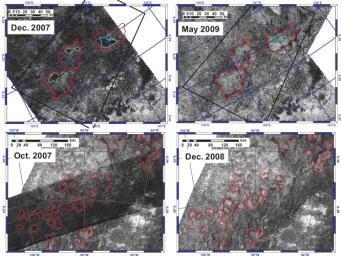These photos show disappearing lakes in before-and-after comparisons of two areas in the southern hemisphere of Saturn's moon Titan. The Synthetic Aperture Radar instrument aboard the Cassini spacecraft allowed scientists to bounce radar beams off the surface of the moon and create images.
In the top left image, obtained in December 2007, the areas in the blue outlines are darker than the surrounding areas, indicating lakes inferred to be filled with liquid ethane and methane. This area corresponds to the right-most area highlighted in red on PIA12280, the composite image of Titan's south pole.
In the top right picture, obtained in May 2009, the dark-light contrast disappears between the areas inside of the blue borders and those outside. This indicates the lakes have disappeared. The red outlines show the larger empty lakebeds.
In the bottom left image, the dark band indicates the radar image obtained in October 2007, where scientists inferred liquid-filled lakes in the lower left part of the swath. There are several shapes outlined in red that are darker in contrast to their backgrounds. The October 2007 swath is laid on top of the lighter-gray December 2008 image to create a mosaic of the larger area, which corresponds to the left-most area highlighted in red on PIA12280, the composite image of Titan's south pole.
In the bottom right image, obtained on December 2008, the contrast between the dark liquid lakes and the dry background disappears. As in the top left and right images, the change in contrast indicates that the lakes have disappeared.
Scientists believe the liquid evaporated out of the lakes during the end of southern hemisphere summer. The lakes pictured measure tens of kilometers (tens of miles) across their widest parts and are unnamed.
These images were presented by Alexander G. Hayes at the Division for Planetary Sciences meeting of the American Astronomical Society on Oct. 6, 2009.
The Cassini-Huygens mission is a cooperative project of NASA, the European Space Agency and the Italian Space Agency. The Jet Propulsion Laboratory, a division of the California Institute of Technology in Pasadena, Calif. manages the mission for NASA's Science Mission Directorate, Washington, D.C.
For more information about the Cassini-Huygens mission visit http://saturn.jpl.nasa.gov.

 Planetary Data System
Planetary Data System












